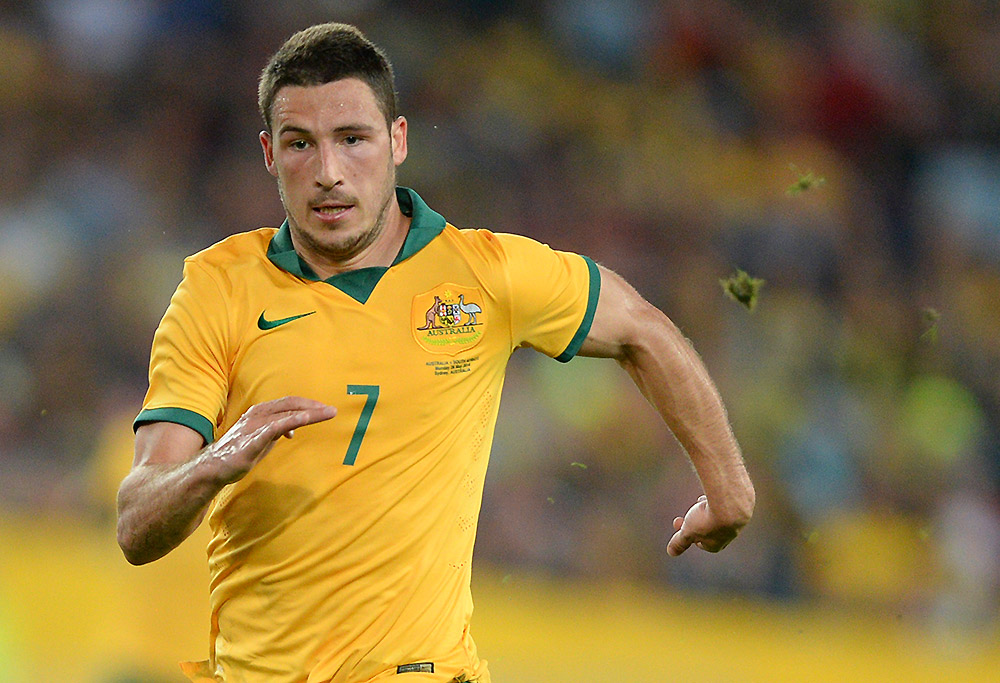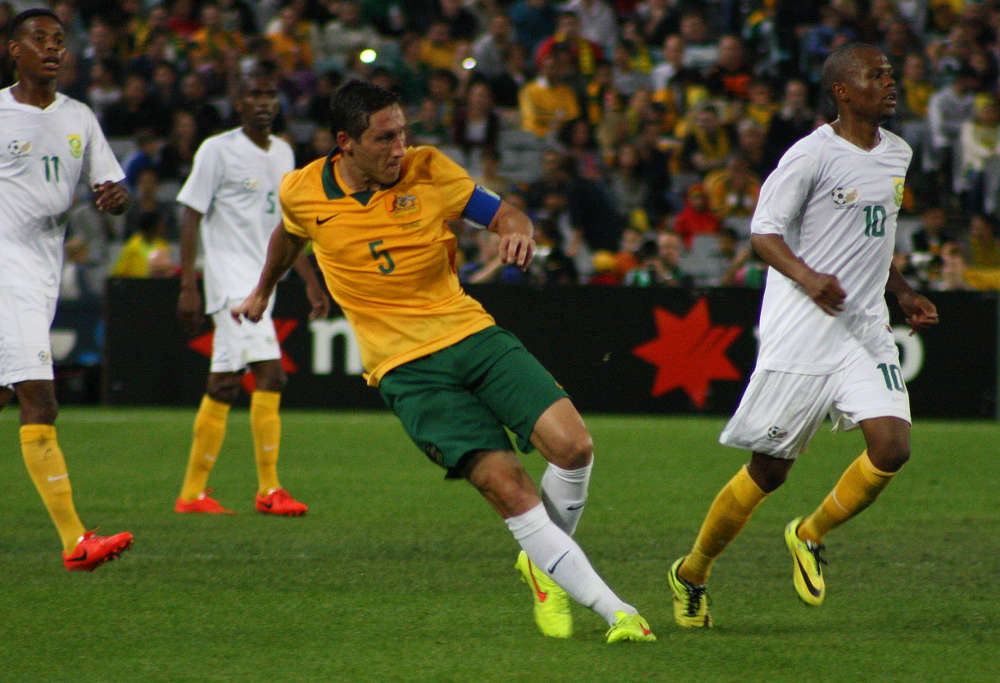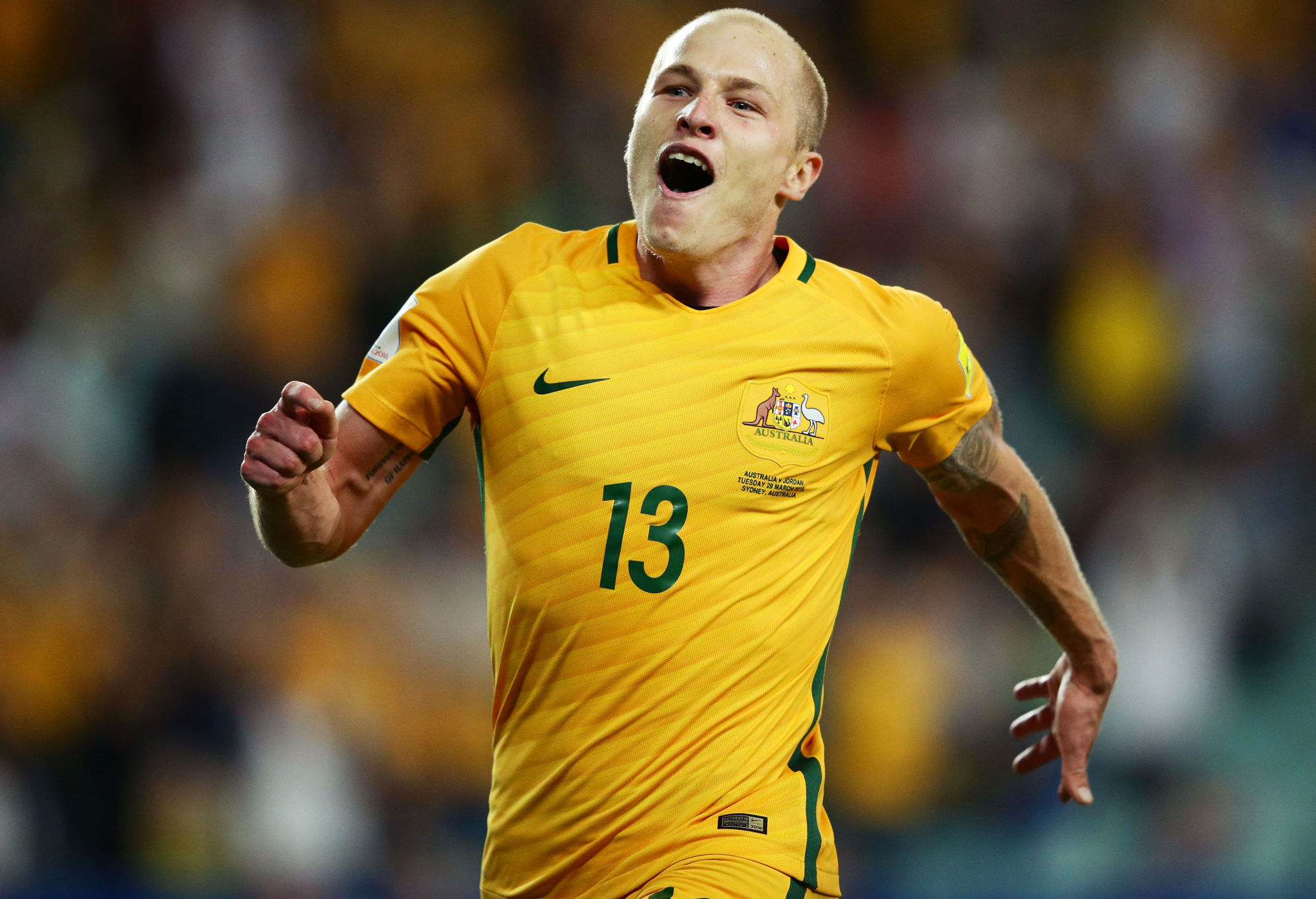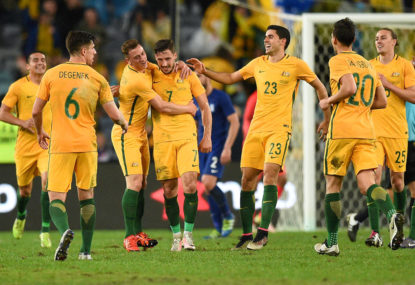Stepping out against a disinterested opponent always makes a team look good. But even so, Australia looked very, very good here.
Mark Milligan’s versatility counts for him in a tournament situation. Bert van Marwijk has clearly decided Milligan’s best position is at centre back, which in turn means Mile Jedinak – though he didn’t appear in this game – will probably be used exclusively in the midfield during the tournament.
Partnered with Trent Sainsbury, the centre back combo made for a pleasing pair on the ball, with both capable of passing confidently out of defence.
The striker position is the most curious selection discussion; why call up Jamie Maclaren when Tomi Juric got injured – assuming Juric was first choice – if not to use him? Was Andrew Nabbout still auditioning in this friendly?
Nabbout has now started two of the three matches under van Marwijk, both at striker. The former Jet isn’t really an out and out striker, at least he wasn’t used – outside of filling in when Roy O’Donovan went down – in that role at Newcastle.
Is van Marwijk planning on utilising Nabbout’s energy and industry as a sort of disruptive influence in the forward line, a defensive striker, if such a thing exists?
Certainly Nabbout is at his best charging up the pitch from deeper areas, or on the wings cutting inside. He isn’t the best at when it comes to straying offside either, a pretty crucial trait for a lone striker playing off the shoulder.
A pragmatic operator, van Marwijk nurses an admiration for graft; the very criticisms levelled at his Dutch side, of how physical it was, how starkly it departed from the cherished aesthetic of Dutch football, are far less applicable to the van Marwijk Roos.
Australia’s team is relatively limited, more suited to the agricultural; there is no shame, like the Dutch decried, in making the Roos, simply, hard to beat.
Van Marwijk may see this approach as our best chance of getting a result, certainly against France, in the World Cup. Nabbout, Matt Leckie, Jackson Irvine, Dimi Petratos; they’re all workers, triers, capable of filling a deficit of quality with huff, puff and toil.

(AAP Image/Lukas Coch)
The team settled immediately into a 4-4-1-1 formation when out of possession, with Rogic hanging ahead of a flat midfield four of Leckie, Aaron Mooy, Mass Luongo and Robbie Kruse, but behind the lone Nabbout up top. Nabbout was haring around helping his midfielders triple-team Czech players, pressuring pass-backs to the goalkeeper, and generally revealing the full capacity of his lungs.
Leckie and Kruse appeared to be fairly flat, almost defensive wingers to start with, level with the two centre midfielders.
A defensive miscarriage appeared within five minutes, as the Czechs passed cleanly through the middle, finding huge gaps between the Sainsbury and Behich on the left. Only a scrambling slide tackle by Sainsbury thwarted things.
It was an odd collapse onto the ball carrier by the Roo midfielders, allowing runners to streak beyond the lines, runners that were easily found with first time passing.
It was clear the centre backs were, by design, to be incorporated into the passing build-up. Mark Milligan struck a lovely long pass up to a streaking Behich in the 12th minute, a few minutes after a fine sequence saw Milligan and Sainsbury combine with Mooy and Luongo to play their way out of a high Czech press.

Mark Milligan. (Peter Macalpine – Flickr)
Multiple times the centre backs and central midfielders would pass triangles among themselves, arranged in a box formation in front of the defensive line, while the full backs crept up the pitch; all of them good passers with soft feet, the risk of turning the ball over with the full backs out of position is reduced, though by no means eliminated. Here’s an illustrated example of it from the second half.
The opening goal was the product of the first real incidence of side-to-side passing for Australia. Milligan’s chipped balls, or speared passes into the final third from Mooy had been frequent, but as soon as Rogic – who had been quiet – was activated, receiving the ball in central space from the left, then the move became dangerous.
Rogic sent a perfect pass out into space on the right, and Risdon’s cross flew out to Kruse on the left side of the box. He cushioned a ball back across goal for Leckie to tap home. Swooping lateral passing had completely flummoxed the Czech defence.
Australia had also done a great job of getting men forward; the lateral passing increases the chances forward runners will be involved, as opposed to vertical balls aimed usually at a single forward runner.
The variety the team seemed comfortable exercising in attack was hugely encouraging, and cut a starkly different silhouette from the blunt monotony that occasionally plagued the late-era Postecoglou Roos. Faced with a high Czech line, clipped balls in behind the defence were a viable method of approach; this led to the defence dropping a little, and now lateral passing – utilising Rogic more – produced some lovely sequences.
The forward line was constructed to be able to execute both methods, and the passing present in the defence greased the wheels for all of it.
Josh Risdon did excellently, in a fairly demanding role. With 15 minutes remaining, he was seen dancing across the edge of the Czech box, before giving it away. He then appeared, seconds later, tackling in his own defensive third, atoning for the error with pure searing hustle. That will have pleased van Marwijk, and it seems like the right-back spot is his for the World Cup. The manager congratulated Risdon when he was subbed.
[latest_videos_strip category=“football” name=“Football”]
Nabbout scored the second goal, showing a sense of poise and precision in finishing that the 50 prior minutes of hard running must have made difficult. Running onto a spinning through ball, Nabbout twisted Thomas Kalas this way, then that way, before striking low and hard across the keeper and into the bottom corner.
When he’s feeling it, Nabbout is a emphatic finisher; the question was whether he could warm his touch up enough in the frenetic surrounds of international football. This was the most breezy, pressure-less of international matches, so although his performance here was promising, the World Cup will be another matter entirely.
The Jackson-Irvine-as-No-10 experiment continued when Irvine replaced Rogic, and took up the same position. He showed the intended effect not long after coming on, bursting onto a Mooy long pass that had been headed up by Maclaren, also a sub. Propelling physically into the final third is what he does best, but his lack of ball-playing ability – compared to Rogic – means he shouldn’t be first choice at No. 10.

Aaron Mooy of the Socceroos. (Photo by Matt King/Getty Images)
It was Australia’s first friendly win on foreign soil in 11 games. It was, just about, the most accommodating friendly warm-up one could want; the Czechs weren’t awful so much as they were, well, absent. It was the football equivalent of sparring against an opponent strictly instructed to only perform the very minimum in response.
Still, such as it was, this was an excellent sparring session for the Roos, and the ability to switch between attacking approaches was very encouraging. Luongo was the unsung hero, playing the full 90; he was central to the stability Australia enjoyed for most of the game. Daniel Arzani was given a very short spell at the end of the game; here lies the most tantalising morsel to think on before the next friendly against Hungary.
































































































